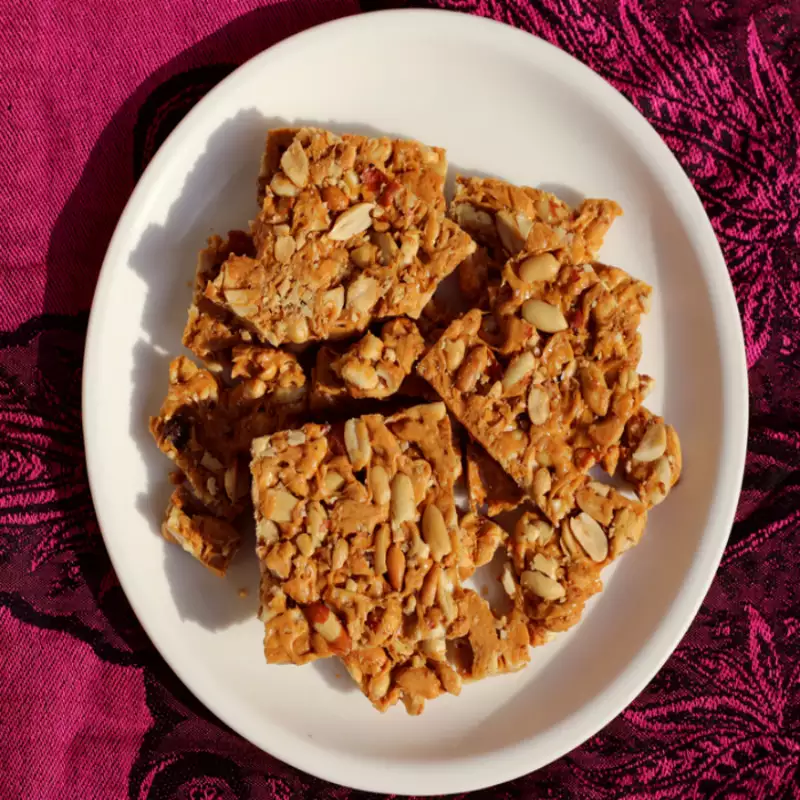Gajak: A Sweet Symphony of Winter Warmth – Straight from Chef Curry Do’pyaza’s Kitchen!
Namaste Doston! Sat Sri Akal! Kem Chho? Chef Curry Do’pyaza here, back in your digital kitchens with a recipe that screams “Winter is here!” It’s time to ditch those boring cookies and embrace the crunchy, nutty goodness of Gajak!
Gajak isn’t just a sweet; it’s a feeling. It’s the taste of Lohri bonfires, the warmth of Makar Sankranti kites soaring in the sky, and the joy of sharing treats with loved ones during chilly evenings. This delightful treat is most popular in North India, especially during the winter months when the air is crisp and the days are short. It is a common custom to exchange Gajak with family and friends during these festivals.
A Bite of History
Gajak has a long and delicious history, rooted in the fertile lands of North India. It is believed to have originated as a simple way to preserve sesame seeds and jaggery, both abundant in the region. Over time, this humble treat evolved into the delectable sweet we know and love today.
Let’s Get Cooking!
Preparation Time: 15 minutes
Cooking Time: 20 minutes
Ingredients:
- 2 cups Til (Sesame Seeds) – Use the white ones for a prettier Gajak!
- 1 cup Gur (Jaggery) – The darker the jaggery, the richer the flavor.
- 1 tbsp Ghee (Clarified Butter) – Adds a lovely aroma and helps bind everything together.
- 1/2 tsp Elaichi Powder (Cardamom Powder) – A pinch of magic for that authentic Indian touch.
- 2 tbsp chopped Badam (Almonds) – Optional, but adds a delightful crunch!
- 2 tbsp chopped Pista (Pistachios) – Optional, but adds a delightful crunch!
Instructions:
- Roast the Sesame Seeds: In a wide, heavy-bottomed pan or kadhai, dry roast the sesame seeds over medium heat. Keep stirring constantly! You don’t want them to burn, just turn a light golden brown and release their nutty fragrance. This should take about 5-7 minutes. Remove them from the pan and set aside.
- Melt the Jaggery: In the same pan, add the ghee. Once it melts, add the jaggery. Lower the heat and stir continuously until the jaggery melts completely and becomes smooth and glossy. Be patient; this might take a few minutes.
- The Syrup Test: To check if the jaggery syrup is ready, drop a tiny bit into a bowl of cold water. If it forms a hard, brittle ball, it’s perfect! If it’s still soft and sticky, cook it for a little longer.
- Combine and Conquer: Quickly add the roasted sesame seeds, cardamom powder, almonds, and pistachios (if using) to the melted jaggery. Mix everything together really well, ensuring that the sesame seeds are evenly coated with the jaggery syrup.
- Shape and Set: Grease a flat surface (like a large plate or a baking sheet) with a little ghee. Pour the sesame mixture onto the greased surface and spread it out evenly with a rolling pin. You can make it as thick or thin as you like.
- Cool and Cut: Let the Gajak cool down slightly, but not completely harden. While it’s still a little warm, use a sharp knife to cut it into desired shapes – squares, diamonds, or even fun shapes for the kids!
- Enjoy! Once the Gajak is completely cool and hardened, store it in an airtight container.
Chef Curry’s Top Tips:
- Don’t burn the sesame seeds! Low and slow is the way to go.
- Keep stirring the jaggery! Burnt jaggery is a sad, sad thing.
- Work quickly! The jaggery syrup hardens fast, so you need to be efficient.
- Adjust the sweetness! If you prefer a less sweet Gajak, reduce the amount of jaggery slightly.
Cooking Medium Variations:
- Gas Stove: The classic method, as described above. Perfect for that traditional taste.
- Induction Stove: Works just as well as a gas stove. Adjust the heat settings accordingly.
- Microwave: Not recommended, as it’s difficult to control the heating and the jaggery can easily burn.
- Oven: Not recommended for making Gajak.
- Air Fryer: Not recommended for making Gajak.
Nutritional Information (Approximate per serving):
- Calories: 200-250
- Fat: 10-15g
- Carbohydrates: 25-30g
- Protein: 5-7g
(Note: This is an approximate estimate and can vary based on specific ingredients and portion sizes.)
Serving Suggestions:
- Enjoy it as a sweet treat after meals.
- Serve it with a cup of hot chai or coffee.
- Break it into small pieces and add it to your morning yogurt or oatmeal.
- Wrap it up as a thoughtful homemade gift for friends and family.
A Humble Request:
So there you have it, folks! My simple yet incredibly satisfying Gajak recipe. I urge you to try it at home. It is a perfect way to bring the warmth and joy of Indian festivals into your home. Make it for your family, share it with your friends, and let the sweet symphony of Gajak fill your hearts.
